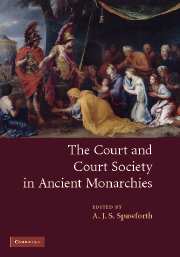Book contents
- Frontmatter
- Contents
- List of figures
- List of tables
- Notes on contributors
- Acknowledgements
- List of abbreviations
- Introduction
- 1 New out of old? Court and court ceremonies in Achaemenid Persia
- 2 King, court and royal representation in the Sasanian empire
- 3 The court of Alexander the Great between Europe and Asia
- 4 Friends in high places: the creation of the court of the Roman emperor
- 5 The imperial court of the late Roman empire, C. AD 300–C. AD 450
- 6 The imperial court in Han China
- 7 Court and palace in ancient Egypt: the Amarna period and later Eighteenth Dynasty
- Bibliography
- Index
1 - New out of old? Court and court ceremonies in Achaemenid Persia
Published online by Cambridge University Press: 22 September 2009
- Frontmatter
- Contents
- List of figures
- List of tables
- Notes on contributors
- Acknowledgements
- List of abbreviations
- Introduction
- 1 New out of old? Court and court ceremonies in Achaemenid Persia
- 2 King, court and royal representation in the Sasanian empire
- 3 The court of Alexander the Great between Europe and Asia
- 4 Friends in high places: the creation of the court of the Roman emperor
- 5 The imperial court of the late Roman empire, C. AD 300–C. AD 450
- 6 The imperial court in Han China
- 7 Court and palace in ancient Egypt: the Amarna period and later Eighteenth Dynasty
- Bibliography
- Index
Summary
Introduction
The need for a systematic study of the courts of ancient Near Eastern monarchies, including the court of the Achaemenid empire, is only now becoming clear. Amélie Kuhrt identified these courts as elements of Near Eastern kingship and the expression of power (Kuhrt 1995). Briant (1996, 2002) offered a descriptive account of the Achaemenid court, although he fell short of providing a historical context or adopting a theoretical approach to the court as a political institution in the sense first defined by Norbert Elias. Most recently Wiesehöfer (in press (c)) has discussed the Achaemenid palace and its importance for the king.
Elias’ analysis asked how the social position of monarch was perpetuated over numerous generations and dynasties and over considerable time periods. He identified the court as a grouping of people who played a key part in this phenomenon and had an immediate interest in preserving the monarch. King and court existed in a relation of interdependence, in which each used the other constantly to reaffirm their position within a strict hierarchical order. Both the king and the court used court ceremonies and court etiquette as vehicles for expressing this interdependence. While the king used them to emphasise his unique position and his social distance from his courtiers, the courtiers used them to display their own position within the hierarchical order of the court. This system led to the creation of a self-perpetuating ‘court society’.
- Type
- Chapter
- Information
- The Court and Court Society in Ancient Monarchies , pp. 17 - 57Publisher: Cambridge University PressPrint publication year: 2007
- 38
- Cited by



